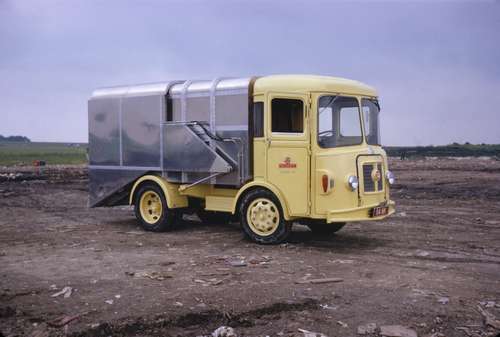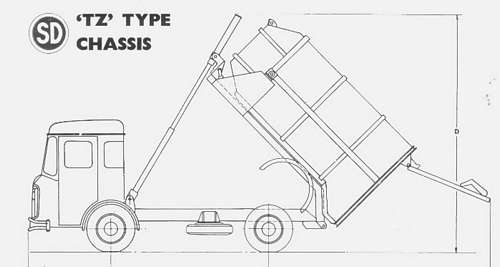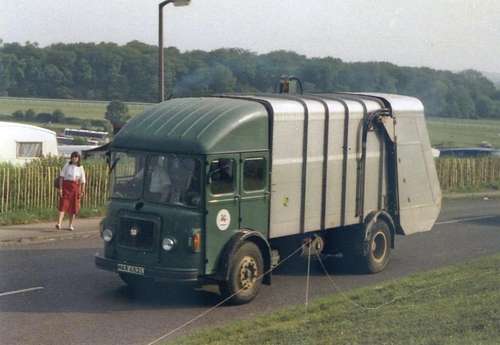Shelvoke & Drewry Refuse Collection Vehicle types.
THE ‘T’ TYPE 1959 - 1972.
By 1959 it
had become urgent to replace the dated 'W' type which had a GRW (Gross
Vehicle Weight) of 8 tons 11 cwt when new regulations permitted
14 tons GRW of four wheels. Chief
Engineer C.K. Edwards had retired, and an abortive attempt at a
replacement ended in failure under the guidance of his successor. Tom
Tillson was recruited from rivals Dennis Bros. and design of the 'T'
type was pursued with urgency.
1959 the ‘T’ type.
The
T type introduced in 1959 has the distinctive fibreglass front which
was fitted to the wooden framed coach built cab. Only the TW and
TY cabs featured the distictive grilles above the headlights and it is
thought that with the introduction of the TY Revopak the grilles were
no longer a feature. Along with the
new ‘TY’ chassis came the Pakamatic aluminium alloy framed compression
body. The Pakamatic can be recognised by the hopper side arms that
extend along the body to produce the lifting motion to raise the hopper
clear when the body is tipped.
Photo supplied by Chris Yeadon.
1960 The TW Fore & Aft tipper.

As
a stop gap measure the TW was introduced with the ‘W’ type chassis but
the new ‘T’ type cab and a redesigned Fore & Aft tipping body, the
vast majority with Power Press compression. Distinctive features on the
cab are the grilles above the headlights and the flat roof compared to
the later 'T' series cabs.
Photo supplied by Jaap Mikkers.
1962? The TN Pakamatic.

A
narrow version of the ‘T’ series was introduced, designated TN, for use
in areas with narrow lanes or alleyways. The overall width was 6 ft 6
ins compared to the standard 7 ft 5 1/4 ins. The TZ chassis appeared in 1964 and around this time the TX was also introduced.
Photo supplied by Jeff Robson.
1969 The Paka Ejector.
Unlike
the Pakamatic’s tipping method the load was discharged by a pusher
plate and the hopper raised out of the way by hydraulic rams to solve
the problem of the instability created by tipping the loaded body. This
was the ejection method adopted for the later Revopak. I have
been unable to find any photos of a Paka Ejector beyond the one shown
as caption 141 in Kaleidoscope of S&D
Mid 1960’s Modifications to the Fore & Aft tipper.

The
tipping method was altered to utilise separate hydraulic rams for
forward and backward tipping of the body in place of the twin rams that
performed both operations. The hydraulic cylinders for the Power Press
were mounted inside the body instead of externally.
1971 The Revopak.

Chassis Type Definitions.
TW
8 tons 11 cwt GVW (As 'W' type) 8' 6" wheelbase 6' 10 " or 7' 5 1/4"
wide, 10' 9" and 11' 6" wheelbase 7' 5 1/4" wide, 13' 0" wheelbase 8'
0" wide.
TN 8.75 tons GVW (N=narrow) 8' 0" or 9' 5" wheelbase 6' 6" wide
TZ 12.50 tons GVW 11' 9" wheelbase 7' 0" wide
TX 13.75 tons GVW 12' 10" wheelbase 7' 6" wide
TY 15/16 tons GVW 13'- 0"/ or 15'- 0" wheelbase 8' 0" wide
Almost 11,000 T series vehicles were produced [Kaleidoscope caption 128] including 1020 TW's [Kaleidoscope caption 132] 160 TX's and 4,400 TY's [Kaleidoscope caption 130]
For other Vehicle Types click
below.





